The nine commandments of small-cap success
Like the Swiss mountain that is its namesake, the team at Eiger is always striving to achieve higher results for its investors. The three founders Stephen Wood, Victor Gomes and David Haddad all met at a Swiss asset manager, and they have applied this clockwork efficiency and process in their approach to cracking the small-cap code.
With over 70 years of collective experience, the team has developed a strategy that looks to uncover the next big idea through an extensive filter of qualitative and quantitative measures.
"We have been working together as an Australian small company specialist for more than a decade and in that time developed an effective investment thesis and system. Our approach's track record has been proven through a range of economic cycles with both markets that are rising and markets that are falling."
Their fascination with the smaller end of town stems from the potential to identify companies that are commencing growth trajectories, as well as those that are set to benefit from global structural trends. In this Fund in Focus, Stephen Wood explains the thinking behind the Eiger Australian Small Companies Fund, how they approach identifying the next big winners while managing downside risk, and provides two examples of companies that fit the process perfectly.
Edited transcript:
Hi there, thank you for your time today. My name is Stephen Wood. I'm one of the principals and a portfolio manager of Eiger Capital. Eiger Capital is part of the Fidante stable of investment managers, and we're a small-cap specialist. Eiger Capital is just coming up three years old, but really has more than a 10-year track record because the three principals - myself, Victor Gomes and David Haddad have been working together for a decade in the small-cap space. Our business was set up as the three of us transitioned from another manager and bought our clients and our track record with us.
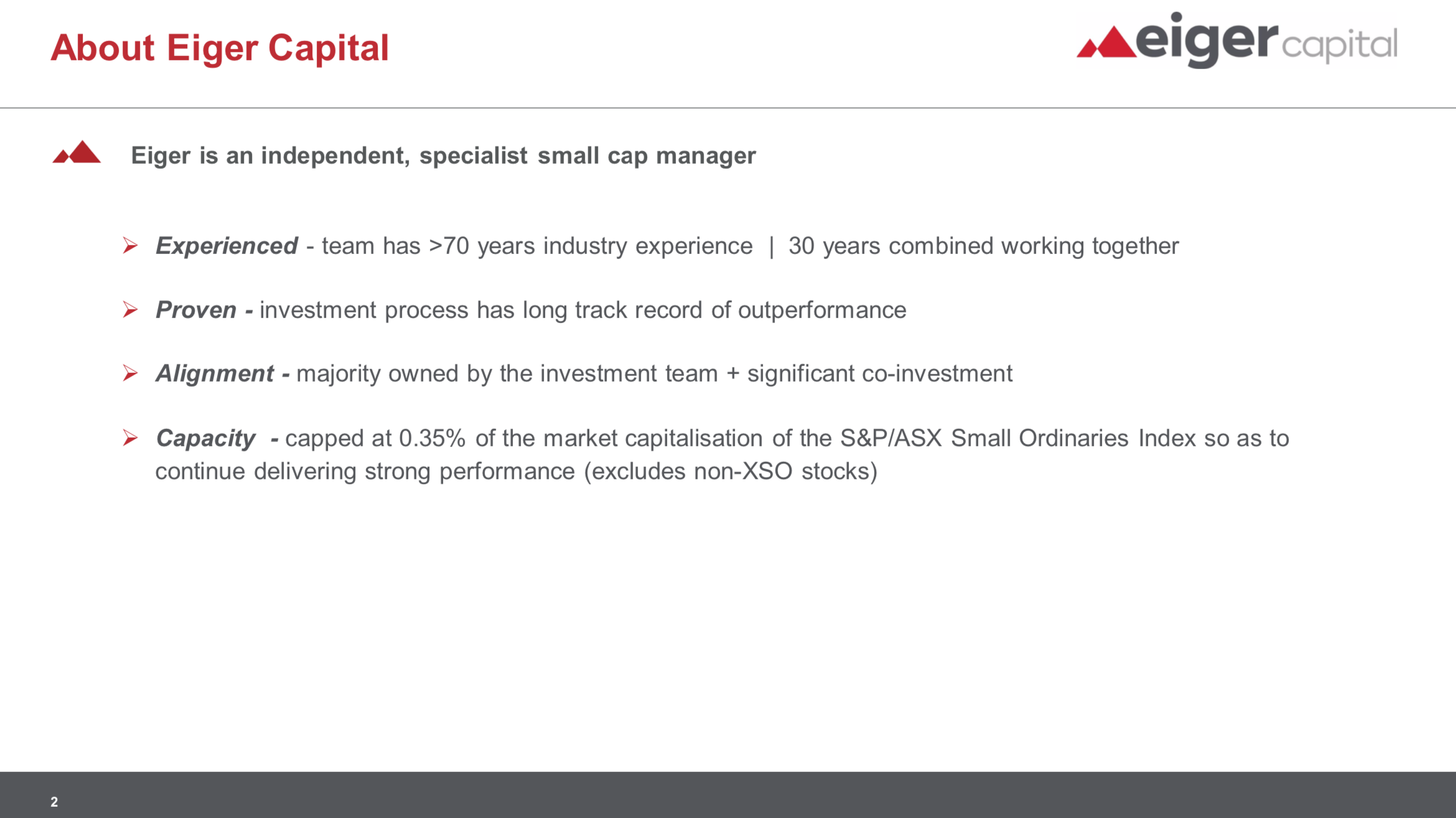
Between the three of us, we have a combined 70 years of experience in financial markets and have been working together as an Australian small company specialist for more than a decade and in that time developed an effective investment thesis and system. Our approach's track record has been proven through a range of economic cycles with both markets that are rising and markets that are falling. It's a cash flow based model, but we'll get to that in a moment.
The other key feature we'd like to point out with Eiger Capital is that we only invest in our product. So we're totally and utterly aligned with our customers, and in addition, the three of us all have a significant stake in the business. So we would like to think that we're completely aligned with our customers in that regard.
The small-cap effect
There's a range of reasons we really like small caps. First and foremost, let's just remember that small companies can grow at much, much faster rates and for longer periods of time than the overall Australian economy.
In addition, the great thing about the small-cap space in Australia now, and this might come as a bit of a surprise, is that it's much more globally diversified than the big caps.
We invest in a range of businesses that have both export operations, for example, in the mining space. We invest in businesses that have substantial offshore operations and we can point to companies like Domino's Pizza (ASX:DMP) for example, who have significant operations in places like Japan, Taiwan, and Europe. We also invest in tech companies whose businesses have spread globally and have fabulous platforms.
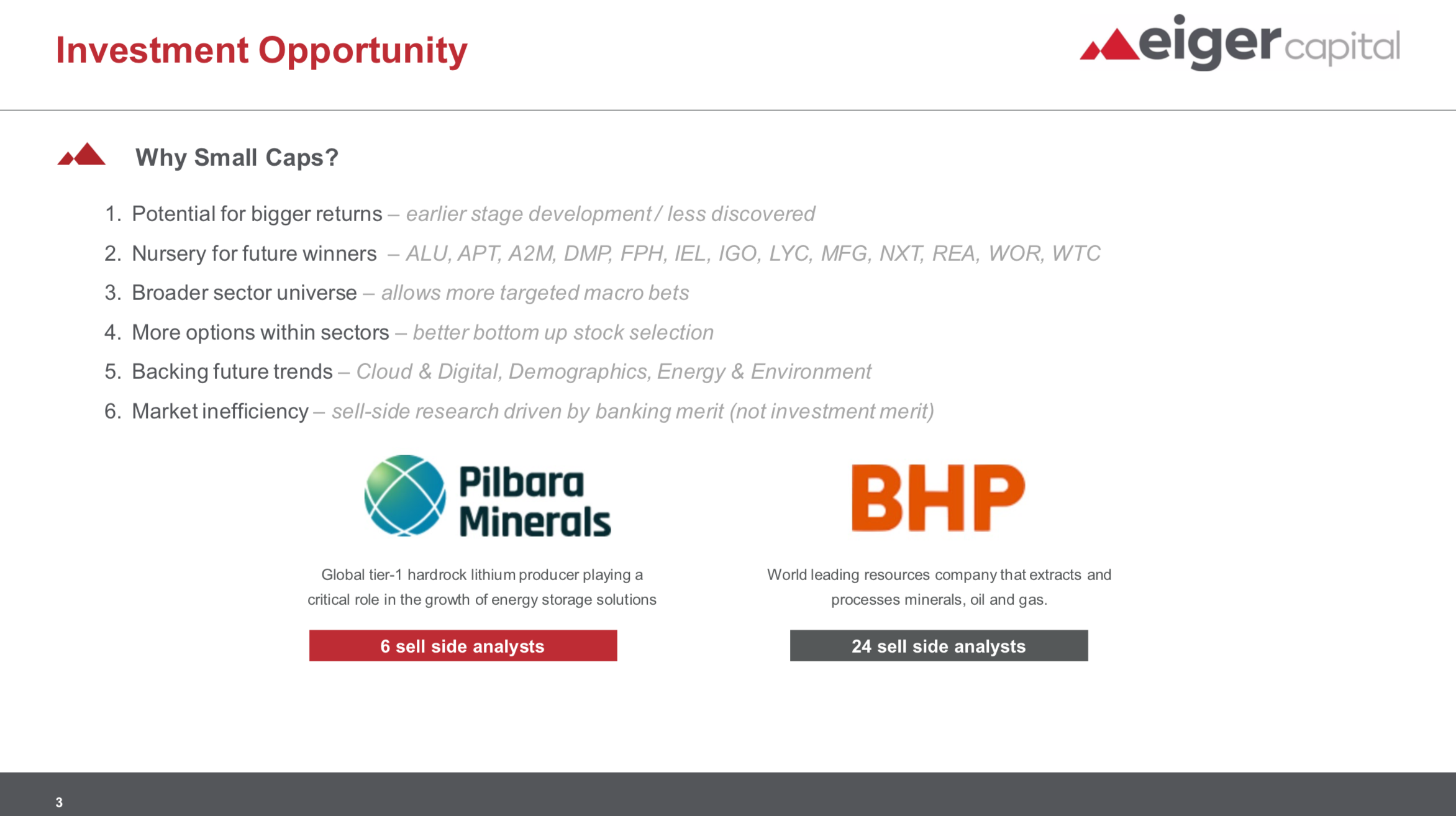
I can point to businesses like Life360 (ASX:360). While we focus on Australian small caps, it's worth bearing in mind that it is the small businesses in Australia that are often globally present. This enables us to invest in businesses that can grow for long periods of time, and importantly are not constrained by the Australian economy.
Finding the next big thing
Firstly, the thing about an investment approach, particularly when you are a bottom-up small-cap investor like ourselves, is fundamentally finding the next good idea.
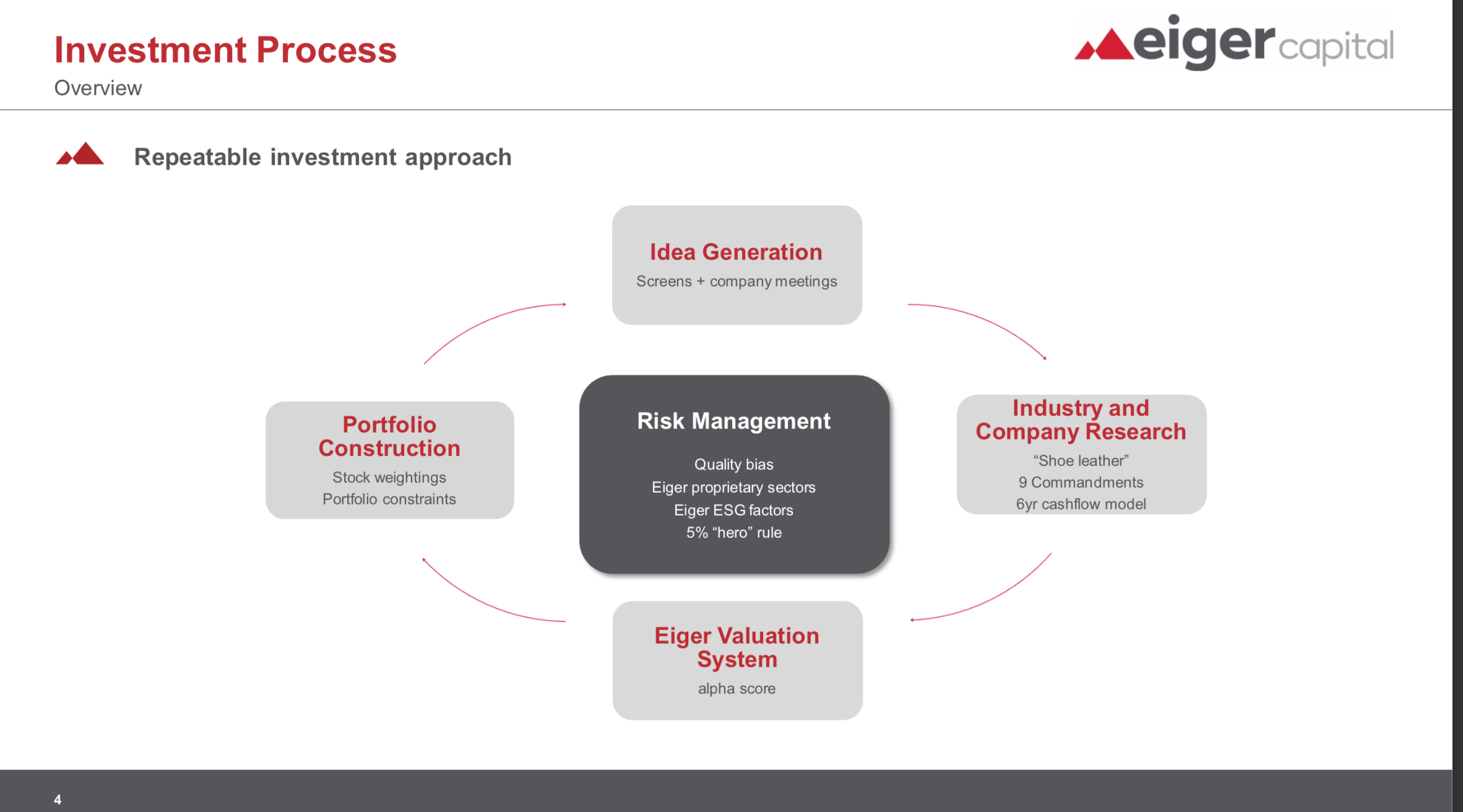
As I mentioned earlier, we've been around for a combined 70 years across the three of us. So we have deep contacts out there in the Australian financial markets and we use those to get ideas wherever we can find them. We are talking to the broad Australian financial community every day. We read a lot. We've obviously got our own views and we synthesise all of that combined with an extensive programme of company visits. We, for example, conduct one-on-one interviews and visit more than 200 companies a year. If you combine that with following the AGMs and other company presentations, that number extends beyond 500 company interaction points per annum.
So we take that top of the funnel and we feed that into our investment process - the standardised model that as I mentioned earlier, we've been using for more than a decade and our track record comes from that.
We take those ideas and funnel them into a cash flow based model where we do our own homework. I will also point out at this moment that we also do invest in resources, which we regard as a key Porter-based financial advantage for Australia. Many of our peers don't do that, but we regard it as a very fertile ground for generating returns for our investors.
So we model up the companies ourselves, we do our own homework, and then following on from that, we apply a range of qualitative filters that have come out of our long term experience, based on our interactions working together and interviewing the companies.
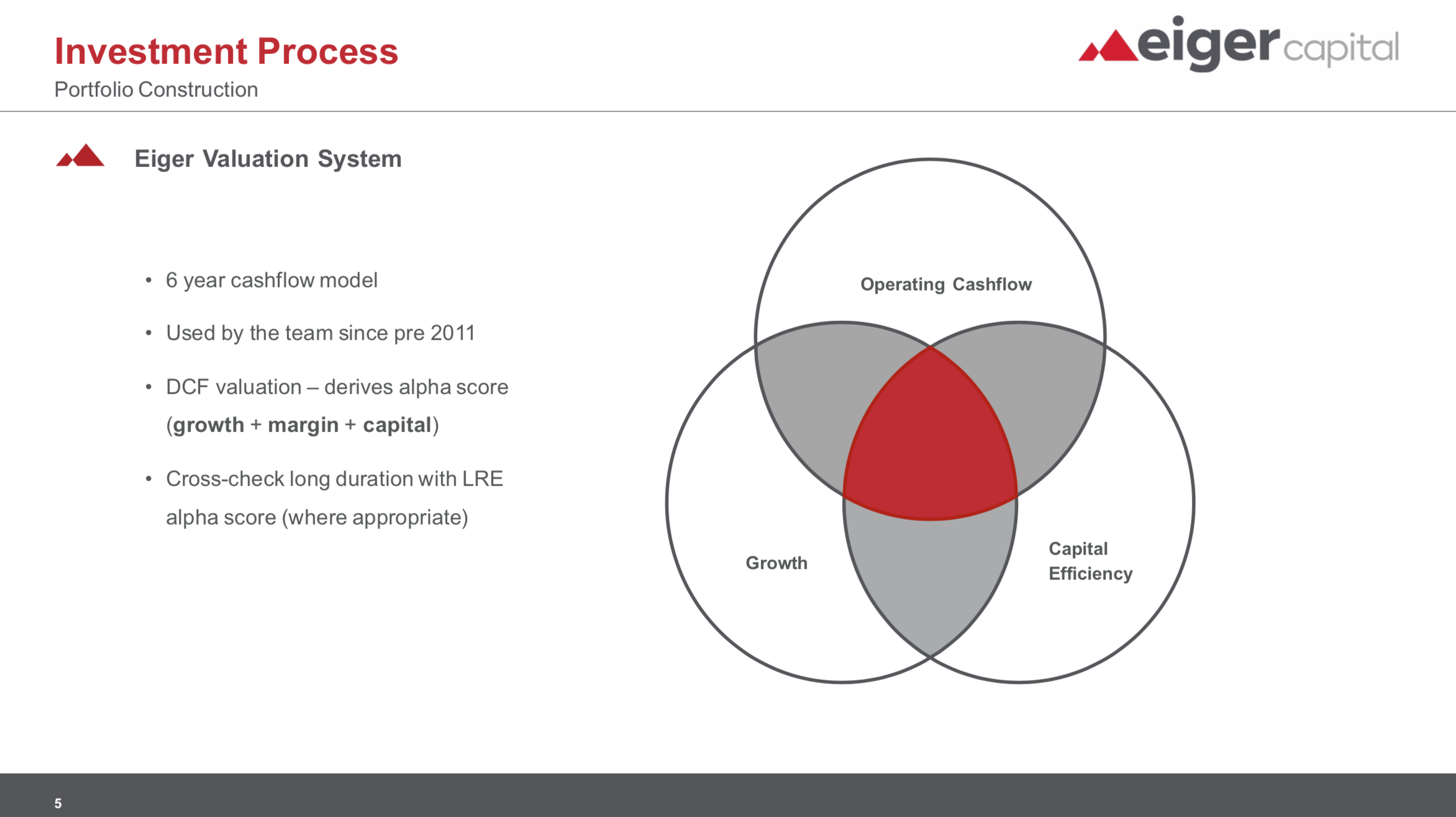
There are three characteristics of a business that when looking to see whether we initially like an idea. As I mentioned earlier, it's just got to grow. We are investing for the medium and the long term, and we want to create wealth for our investors over that 5-10 year period. We want to give them real money that they can retire on and take to the shops and spend.
In our view, the best way to do that is just fundamentally to find companies that just get bigger, because if companies can get bigger and they can make a good profit along the way, share prices go up and wealth improves.
So what are the other characteristics we look for? Number one as I mentioned was growth. Number two - as you can see on this diagram - clearly at some point over that 5-6 year period that we focus on, a company has to be able to generate a good operating cash margin. Hence, we want growth and at some point during the investment cycle, we want some margin and preferably one that expands as the company gets bigger. And finally, the third key factor we look at, which is something that is very often overlooked by financial markets in general is the cost of delivering both growth and margin.
That cost is linked to capital expenditure, the cost of acquiring businesses (if you're going to grow that way), or the cost of investing in intangibles - things like software for example. Our model prices a combination of growth, margin and the cost of achieving these two factors. That then gives us a ranking score, which we call an alpha score - but we are not formulaic asset managers.
We rely on our experience and we rely on some lessons that we've hard-learned over a long, long period of time. And we call these our nine commandments.
The nine commandments
They're set out on this page. Some of them are a bit hokey and perhaps a bit obvious.
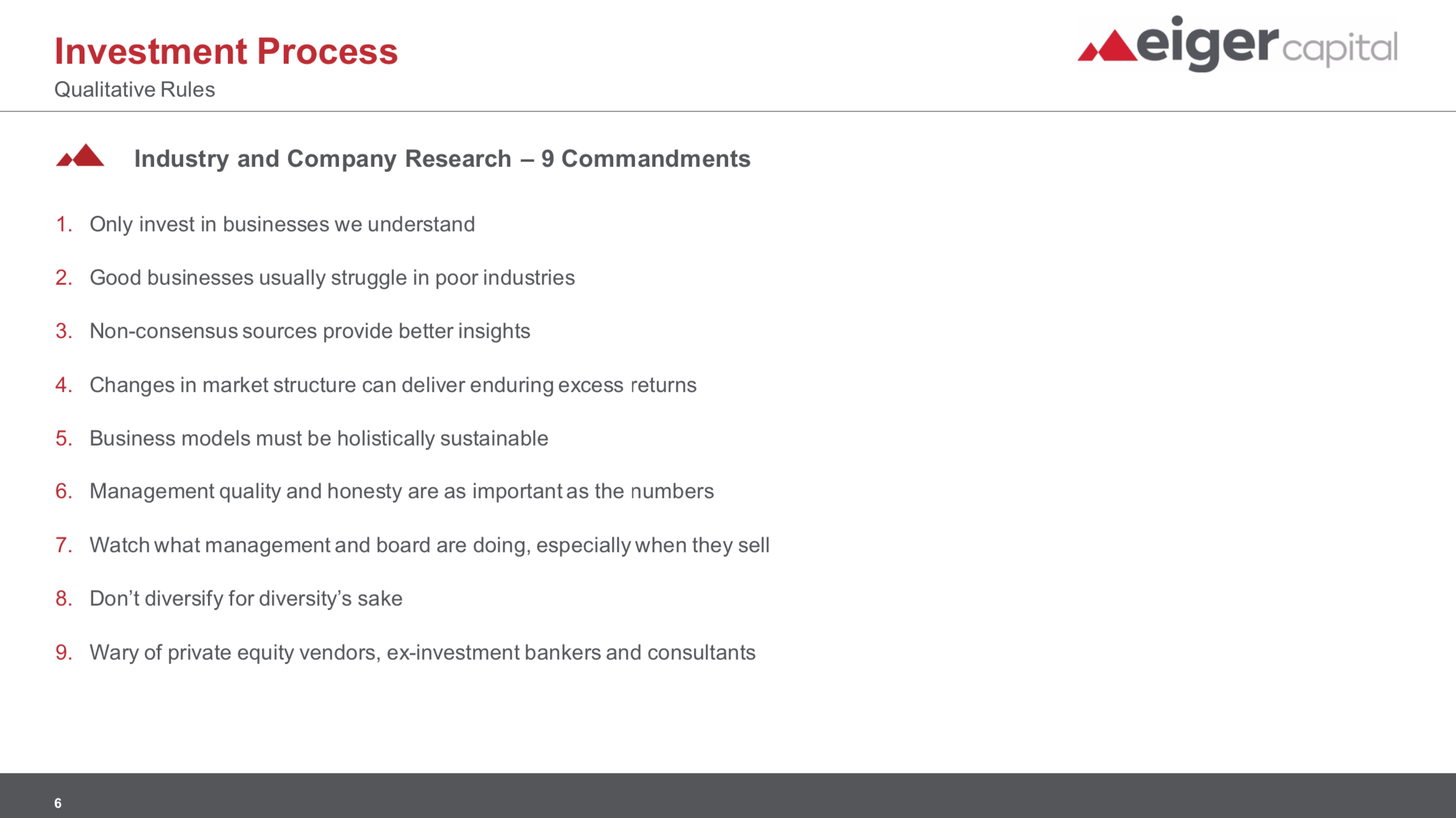
We invest in businesses that we understand. We try to avoid poor industries - which often get flushed out in the modelling process because companies in poor industries tend to continually invest and not grow. So it's very interactive in terms of what we are doing between the modelling and our quality filters that you can see here in our nine commandments.
We like to invest in industries that have structural change occuring, industries that are the industries of the future and not stuck in the past.
There's a couple of commandments on this page that people often laugh at and go, "Well, what's all that about." Take for example, number seven, we're very focused on what our management teams are doing with their own stakes in these businesses. We don't like it when management sell large amounts of their stock, often in the run-up to results. We take a pretty dim view on that. We often sell out and never ever go back.
The last one always gets a smile. Everybody thinks that the small-cap game we are in is probably all about IPOs and snuggling up to investment banks. The truth could not be further away. We do not generally participate in IPOs. We take a pretty dim view of investment bankers who become managing directors of our companies.
By and large, if companies employ large amounts of consultants, we also don't like it. We want to employ management who know what they're doing, not management who rely on a whole bunch of consultants to tell them how they should be reshaping their business for the future.
Understanding the investment opportunities
Really what we are looking for over a 5-6 year view is companies that grow, generate a margin, as well as management we can rely on and trust, and that give us the confidence in their ability to generate those 5-year numbers and have a reasonable outlook that might actually be achieved. These businesses just compound up your wealth over a reasonable period of time. And that is highlighted by these two slides. They either just compound up, or we get structural change in an industry and that over two or three year period that plays out and a company's margins improve.
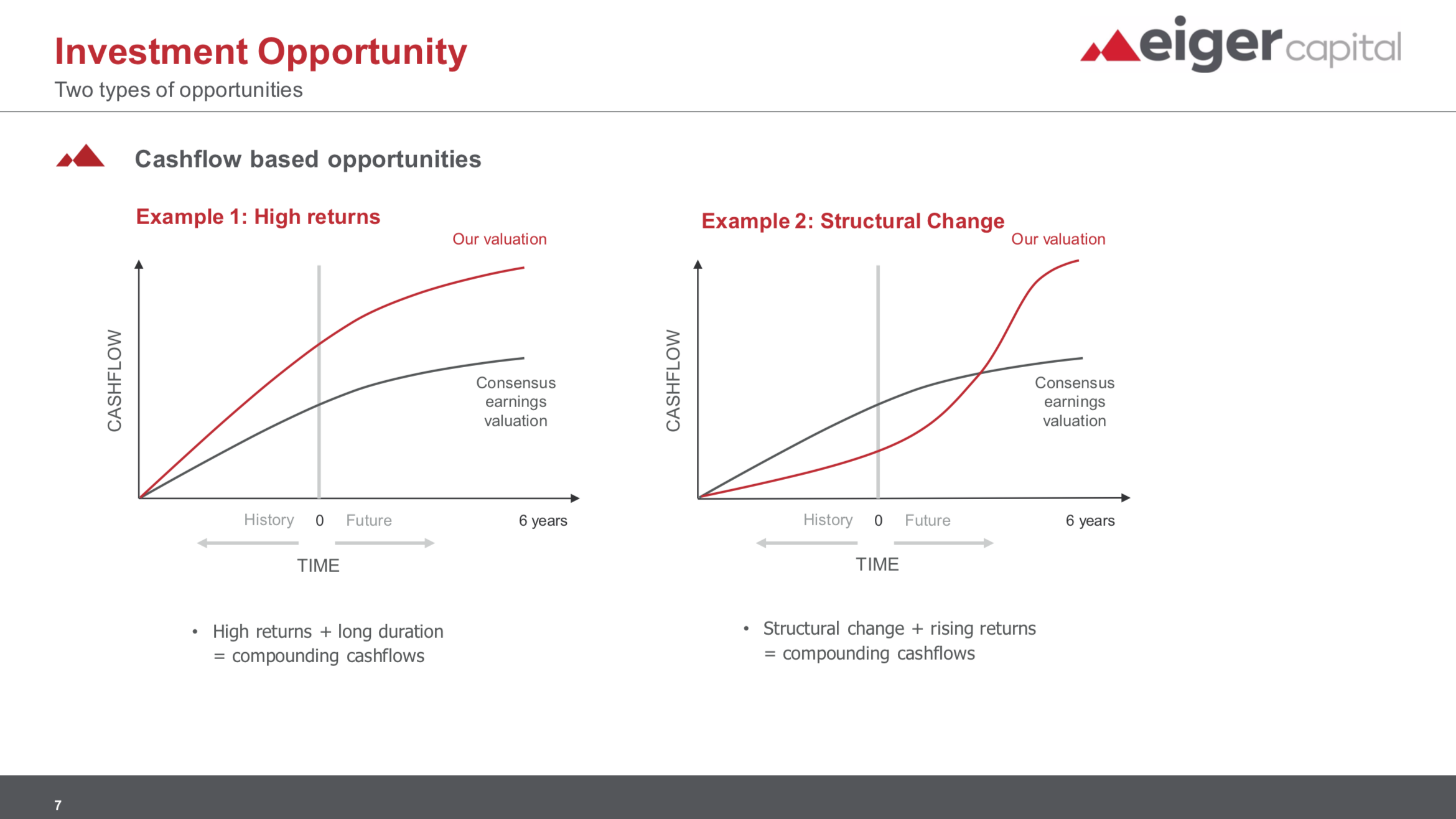
In the venn diagram below, you can see those two forces are either separate or interactive. We're happy with one, we're happy with the other. Or you can get some companies like Technology One and Life360, which have been a couple of our really successful investments over the last half-decade, who sit right there in the middle.
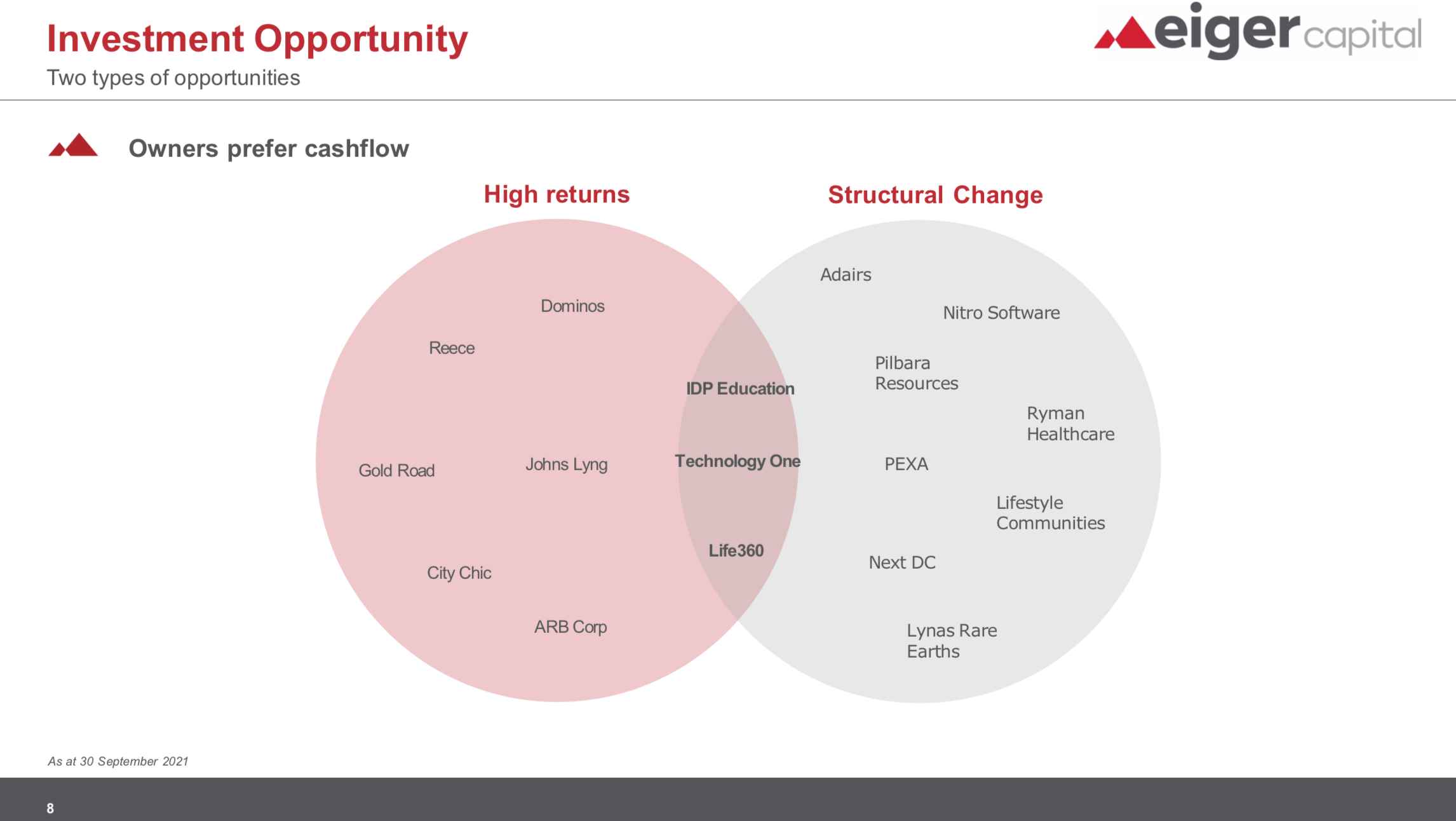
Building the fund
Our fund is benchmarked against the S&P ASX small ordinary index. We have a limit of a 5% active position in the fund so that no one position ever gets too big and that probably is a key part of our risk management as we put the portfolio together.
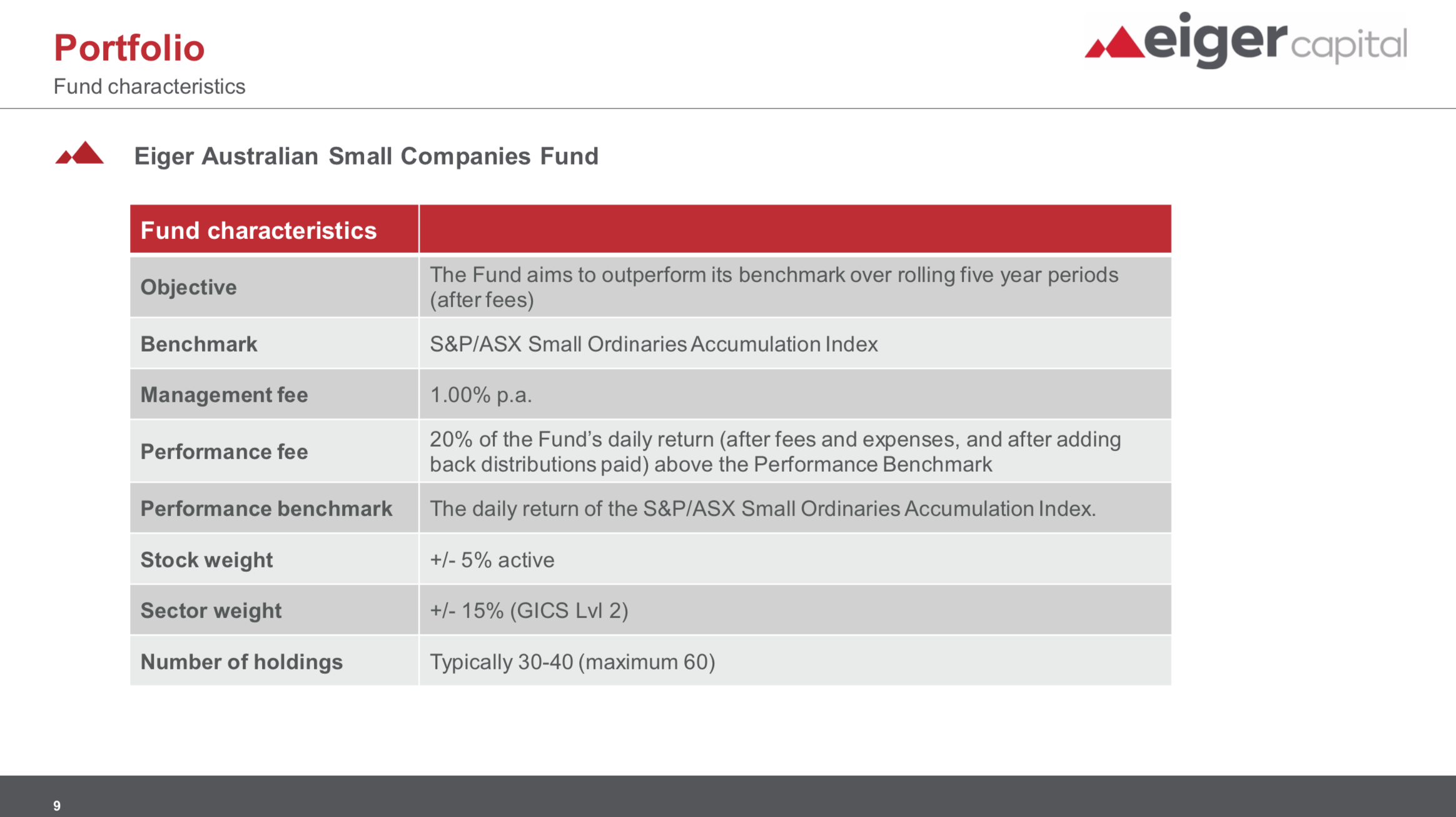
There are typically 30 to 35 names. With the maximum weight in the portfolio of about 5%, if we can generate alpha we'll end up with a return that at a maximum is as risky as probably the ASX200; It is less risky than the small odds because we do diversify the portfolio with about 30-35 names as I mentioned.
These are the returns set out for our fund over the course of the last more than 10 years. As I mentioned at the start, Eiger Capital is only three years old. You can see that in the top half of that page, the bottom half sets out our track record, going back to the point where myself, Victor and David came together at a former employer, and it is worth bearing in mind that our track record there is contiguous. There were no gaps between where we were before and the establishment of Eiger with Fidante.
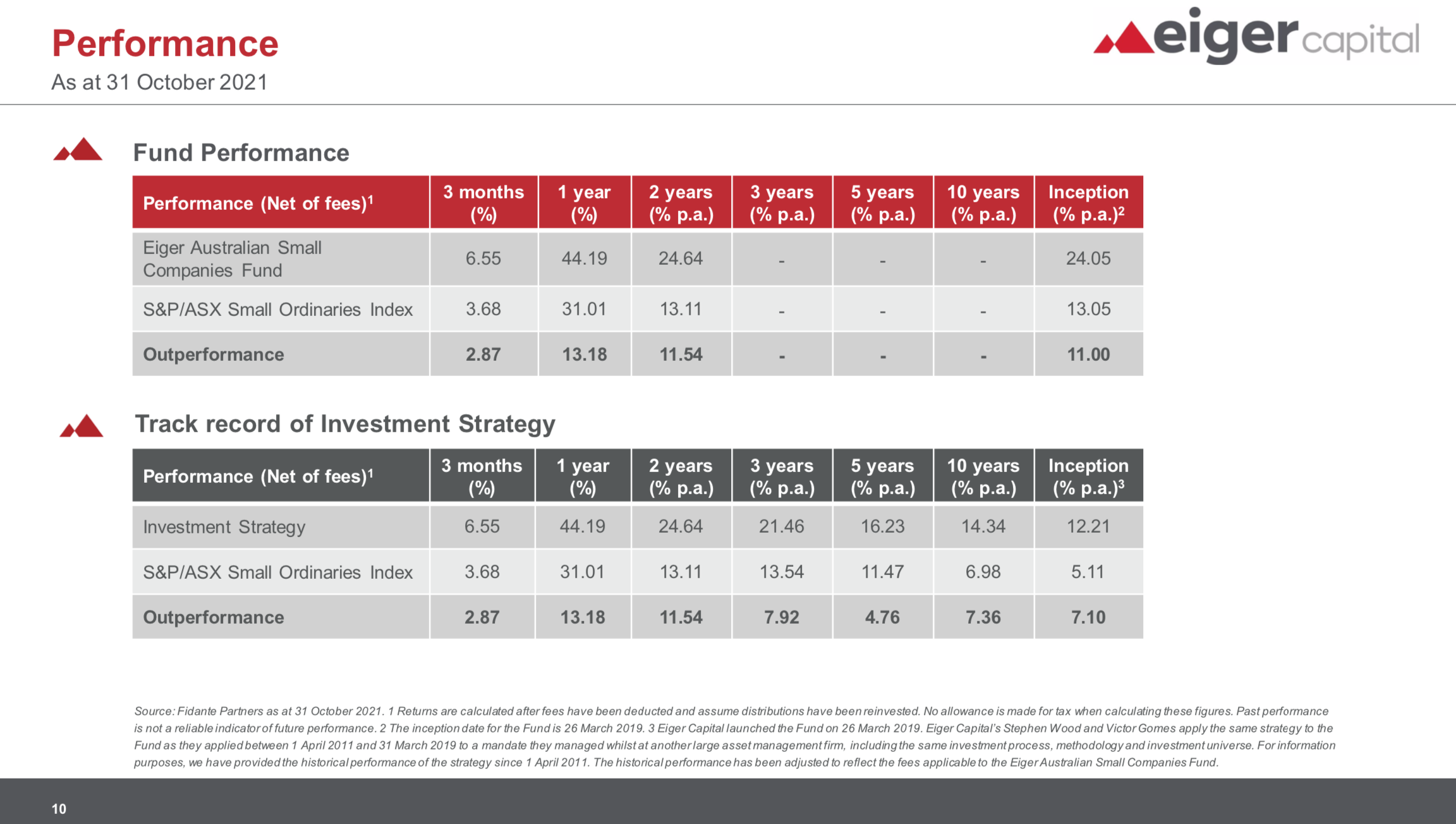
Spotlight: ARB Corporation
Perhaps now I'd just like to come to a couple of stock examples of companies that we've held, over a decade in the case of ARB. ARB makes bull bars and car accessories. They are just a fabulous business based in Melbourne. It's still run by its founders and has been around for a long time. It's an Australian iconic brand. But when you get to know this company, you might be sitting there saying to yourself, they make bull bars and racks for the back of a Toyota Hilux. How can this be the type of business that you want to invest in for the long-term?
It fundamentally comes back to the fact that this is just an exceptionally well managed company that make an exceptional product, and it might sound simple, but it's not that easy and it is worth reflecting on. You can on the slide that they are now one of three global suppliers to Ford for their new Bronco, which has just been released to much fan fair in the US - they're selling like hot cakes and all accessorised with ARB goods.
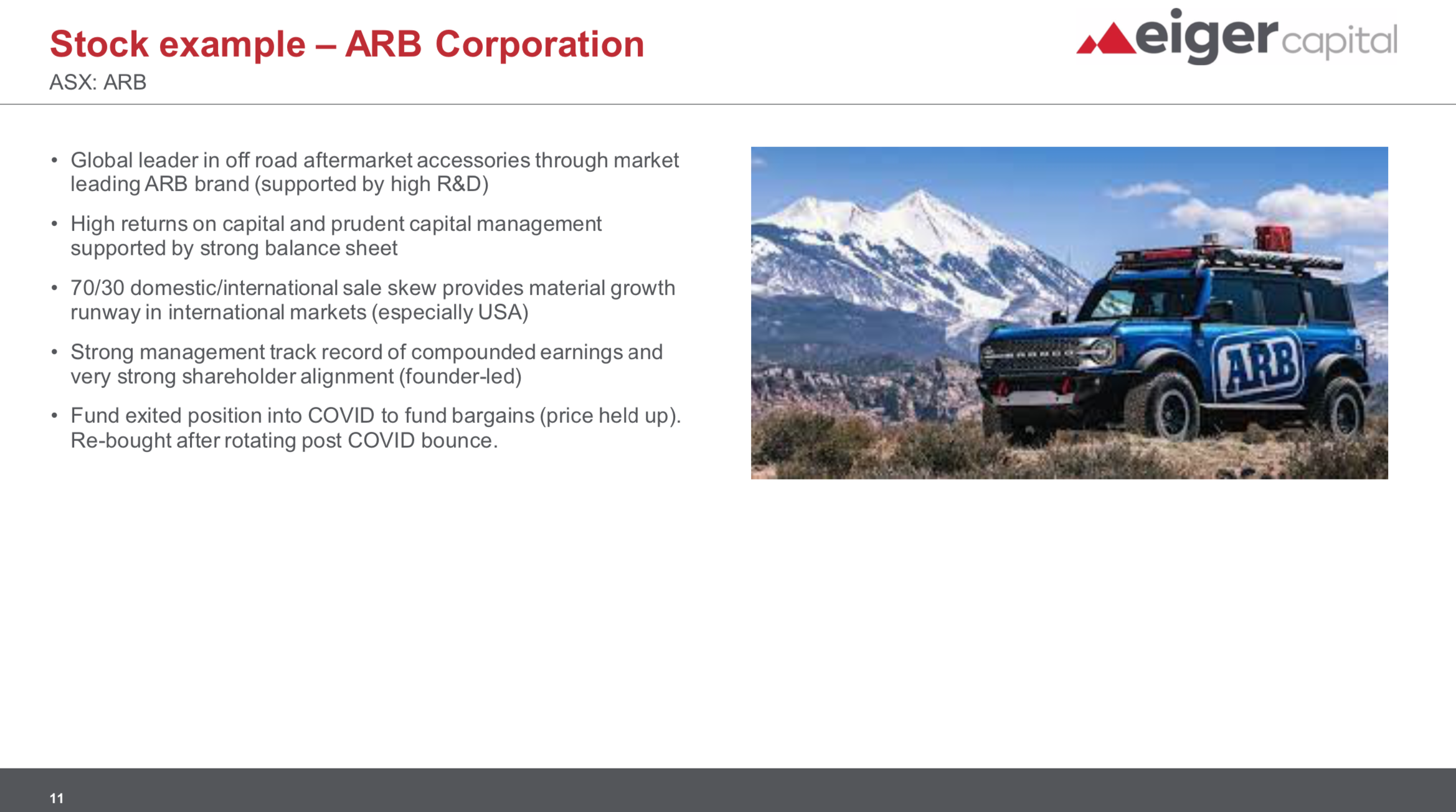
As I mentioned right at the start, often investing in small caps is not about seeing that tradie's Hilux driving around in your neighbourhood in Australia. Reflect on the fact that that the equipment is made in Thailand by an Australian small company, and it ends up on the hottest selling 4x4 in the US.
That's often what investigating these companies is all about.
Spotlight: Pilbara Minerals
Flipping to perhaps a structural change in the advent of EVs and the rollout of smart grids, which are coming to us thick and fast, just how much energy is going into the sector worldwide.
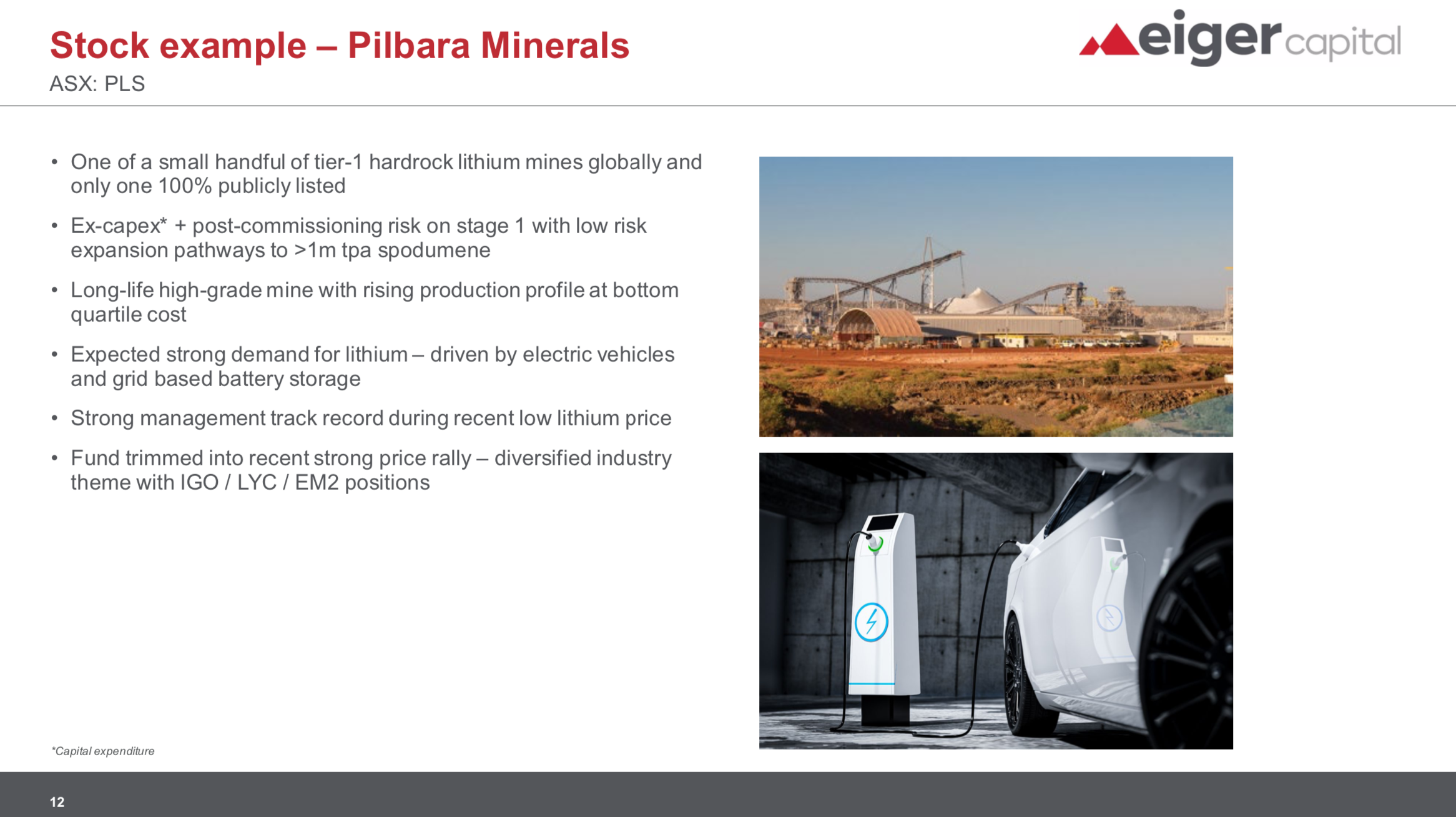
One of our favourite and best-performing businesses over the last two or three years has been Pilbara Minerals. We are big believers and investors in what we all call advanced minerals (lithium, rare earths, cobalt). These elements are essential for batteries, battery technology, and advanced vehicles such as the new electric F-150 that's about to go on sale in the US. The world's biggest-selling vehicle is going to be full of batteries and the lithium, cobalt, rare earths and the copper have got to come from somewhere.
In the case of Pilbara, it is already has one of the world's largest, longest life lithium mines anywhere. It's been a spectacular performer for us in the last few years because lithium has now become a real focus and this is a big mine right at the bottom end of the cost curve and the mineral is now in high demand.
Thank you very much for your time. If you want more information on Eiger Capital, please feel free to visit our website or fill out the contact form below. Thank you once again for your time, and we look forward to hearing from you soon.


2 topics
6 stocks mentioned
1 fund mentioned
3 contributors mentioned


